This week we’re honored to feature Billie Frank as a contributor. Billie is freelance writer based in Santa Fe, New Mexico; she writes about art, history and culture on SantaFeTravelers.com. In this post, Billie shares memories of her childhood in the East Village, which is now one of New York City’s trendiest neighborhoods.
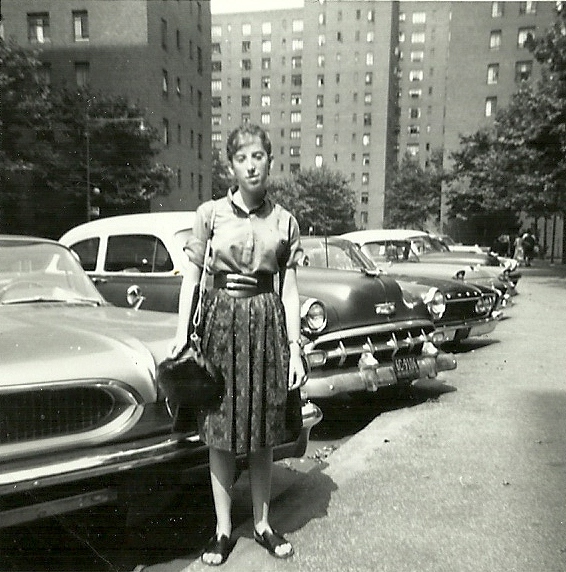
Billie dressed in "Greenwich Village apparel," circa 1959. Her belt, sandals and purse were all handmade. (photo: Billie Frank)
I grew up in the 1950s in Stuyvesant Town, a middle-class development built after World War II to help alleviate the housing shortage in NYC. This little city within a city, home to over 40,000 residents, displaced many people who lived in the 19th century tenement buildings razed to make room for it.
In many ways it was a great place to grow up. You could ride bicycles safely on the wide, car-less pavement within the project’s boundaries and roller skate with impunity. There were playgrounds and even a fountain, the development’s centerpiece, in an area called The Oval. As kids, we truly had freedom. But to me the chained in grass, the playground bars, the grounds patrolled by uniformed cops and countless rules made it feel like a middle-class prison.
The surrounding neighborhood was vital and undergoing a dramatic transformation, following the Depression and the subsequent war. The men were home, the women were back in the kitchen and American life would never be the same.
As a child, I remember seeing horse-drawn carts with the last of the rag-pickers and the gradual shift of the area south of us from Italian to Puerto Rican. As I look back, I have many vintage memories of the East Village and the Lower East Side.
I went to PS 19 on First Avenue between 13th and 14th Streets. It was over 100 years old and downright spooky. Its main claim to fame: Abraham Lincoln spoke there. Walking to school each day, I passed the Italian butcher shop, carcasses hanging in the window, and the fish monger, the dead bodies of fish, heads and tails intact staring up at me from their bed of ice; a little daunting to a six year old. The Italian grocer on the corner, narrow and dark, redolent of those smells only an Italian grocery has: Parmesan cheese, olives, prosciutto and more; funky smelling to a young, untrained nose.
I remember the bodega where the Puerto Rican owner spoke no English and I stood with a nickel or dime in my grimy hand working hard to choose penny-candy from the glass case. “Mira, mira,” we’d all shout, excitedly pointing to what we wanted that day. Then, task complete, walking out into the sunshine, extra bright after the darkness of the store, hands full and a smile on my face. Victory! I’d have treasures: dots (those pastel half-circles of sugar pasted on a long strip of white paper), Smarties, miniature wax Coke bottles filled with dark syrup, red wax lips, candy cigarettes, Necco Wafers and more.
Our new school opened when I was in fourth grade. It was two blocks farther south on First Avenue between 11th and 12th Streets; further into the unknown land that was the East Village.
Across the avenue, Lanza’s, an Italian restaurant, occupied the same spot since the 1920s. It seemed so old: small white octagonal tiles on the floor, wainscoting and mirrors and pictures of Italy on the wall, bent-wood chairs at the tables. It was a little more expensive than the other Italian places we went to, but my dad was sentimental about the place. He remembered eating dinner there for $0.85 during THE war. It was the first place I ate Veal Marsala. I remember the sensation of the buttery meat melting in my mouth.
The Italian ice place next-door was an important stop after dinner at Lanza’s or after school on a hot day. The soothing lemon ices, smooth and tart, were served in a pleated paper cup. You’d squish it to get the ices to come up where they could be licked, I can still feel and taste them on my tongue.

Lanza's Restaurant is still operating in the East Village, although its prices have increased considerably since Billie's childhood. (photo: L Koch)
I remember the Tompkins Square Library on 10th Street between Avenues A and B where my first picture books came from; books I would later read to my son: The Little Red Lighthouse, Bartholomew Cubbins and The 500 Hats; later William Saroyan’s The Human Comedy and A Tree Grows in Brooklyn.
The free treasures within this two-story building shaped who I am today. A life-long love of books was born here, passed on to me and nurtured by my mother. Books were the family legacy. My grandfather, a fixture in the used bookstores on 4th Avenue, would buy books rather than food for his family. I, in turn, have passed this on to my son who is passing it on to his.
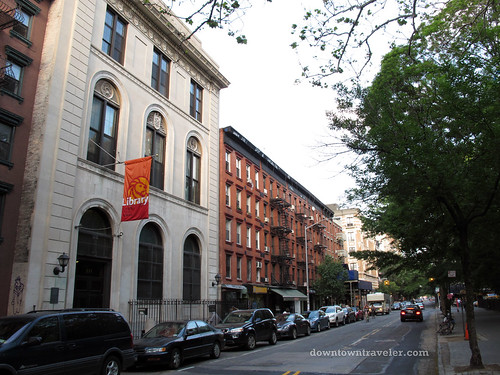
The Tompkins Square Library on East 10th Street, where Billie developed her love of books. (photo: L Koch)
Memories come fast and furious: afternoons spent riding the red Avenue B bus to the Henry Street Settlement for dance classes and the Third Street Music School for piano lessons; egg creams at Gem’s Spa on St. Mark’s place; dairy at Ratners. I saw my first off-Broadway musical, Once Upon a Mattress, at the Phoenix Theater on 2nd Avenue and 12th Street starring a virtually unknown Carol Burnett.
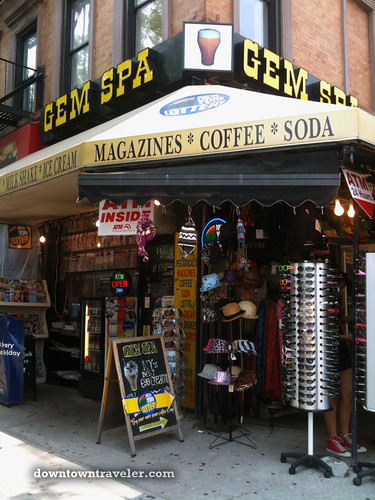
Billie frequented Gem's Spa. Now a newspaper stand, it still claims to have "NY's best egg cream." (photo: L Koch)
I remember occasional Sunday forays to Orchard Street on the Lower East Side with my father and my Uncle Max who owned a dry-cleaning store. He’d need supplies (thread, lining or suit goods) for Alessandro, his Italian tailor, who had to be taught to put zippers in trousers. He made my dad a pair with buttons.
There was a hustle and bustle here. It was a life different than the protected one of the middle-class prison we called home. The best part of these outings was getting to pick a kosher dill pickle straight from the barrel. If I was really lucky; the day would include a trip to Katz’s Deli (immortalized many years later in When Harry Met Sally), for a hot dog with sauerkraut and mustard and an order of their crispy French Fries.
The Lower East Side was the southern boundary of my life until I left home for college. If I went back to this gentrified piece of real estate today, I probably wouldn’t know where I was. As a great writer once said, “You can’t go home again.” But, maybe you can; I just did for a moment.
About the Writer
Billie Frank was born and raised in New York City but now calls the American West home. She has been a concierge at fine hotels and owns The Santa Fe Traveler, a travel-concierge, trip-planning business and tour.
Read Billie’s insider tips for visiting Santa Fe on her blog, SantaFeTravelers.com, and follow her on Twitter (@santafetraveler) and Facebook.
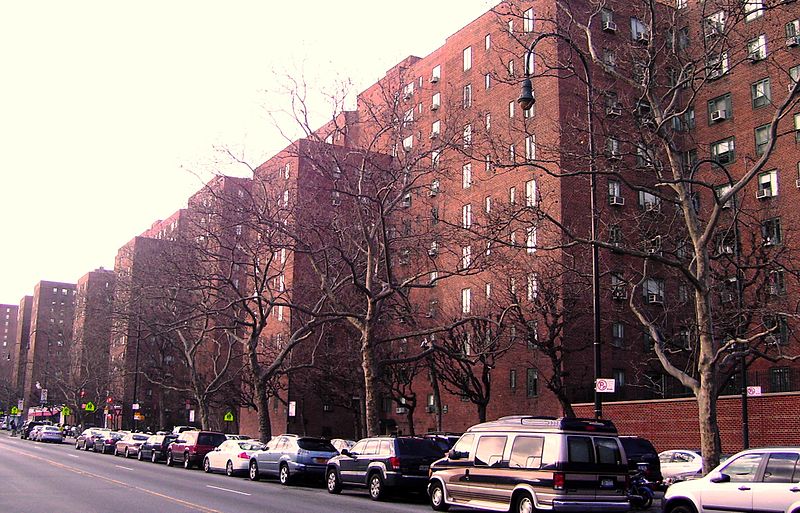
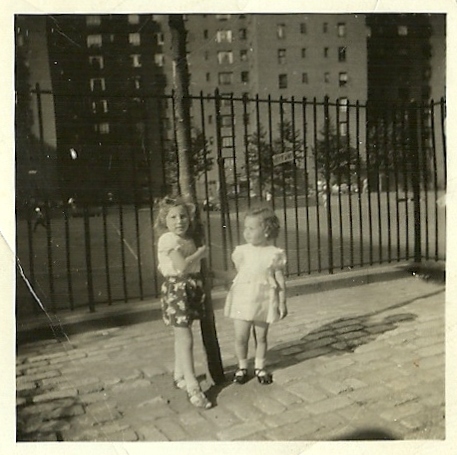
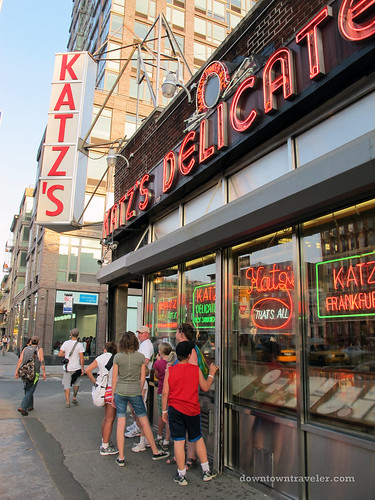
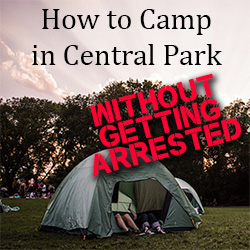









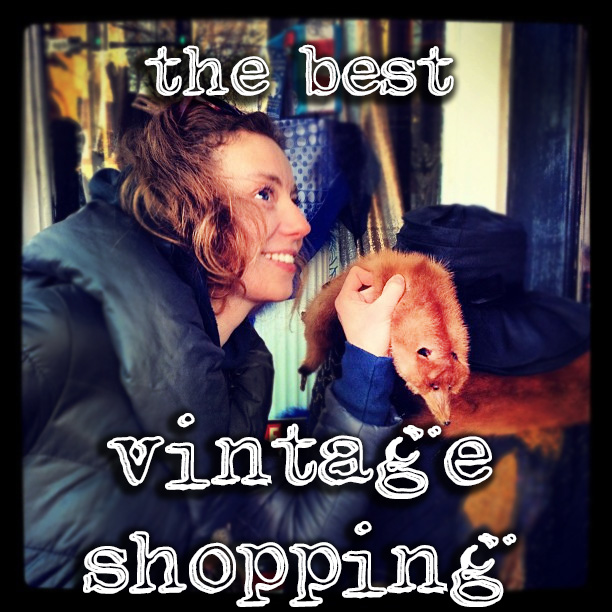


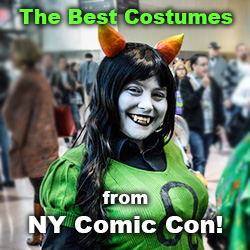


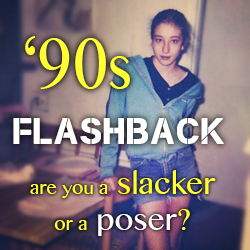
Thanks for indulging me and my childhood memories! Stuyvesant Town looks short in the contemporary photo. Those buildings seemed towers when I was growing up. The library looks pretty much the same as does Katz’s. Lanza’s looks way more glitzy and Gem’s Spa looks out of control. Wonder how the egg creams are. It’s very Proustian to revisit all these sense memories. Thanks for letting me do it.
BTW- I should have identified her- the little girl is my cousin Doris, a year younger than I am.
What a great flashback to those days in New York! Thanks for sharing Billie!
Thanks Jeremy. Love Billie’s description of the neighborhood in the 50s. I actually live there now and had fun snapping photos of the landmarks Billie mentioned.
Thanks, Jeremy. It was a lot of fun. I’m so glad Leslie let me do it.
Even New York City was a more innocent place in more relaxed times. What great reminiscences. Thanks for sharing another view of a bygone time.
“send a salami to your boy in the army”
I absolutely loved this walk back in time with you, Billie. Your words and photos painted such a vivid picture. You’ve got me reflecting on my growing up years. When I was growing up in a small town, I always wondered what it would be like to be living in the big city.
Write them down. It’s really a great experience.
A wonderful well written reminscince of childhood in New York. While reading I closed my eyes, and I could actually see New York through Billie’s voice, but then I had problems reading because my eyes were closed.
I can understand why you love Santa Fe so much as it is so different from New York. It is obvious you still have feelings for New York, butt cool that you fell in love with the west.
I was a small town girl trapped in a city family. In my early 20s I left the city for the beautiful Hudson Valley and really never looked back. I fell in love with the southwest the first time I visited in 1973. It just took me a long time time to get here. But writing that made me nostalgic. I’m ready to go back for a visit.
Ted, I’m glad you opened your eyes and kept reading 🙂
Billie,
I lived in that same bit of real estate on 16th Street and Avenue C from 2005 – 2009. I know the time withered away much of the authenticity of the place but I would argue that Stuy Town still exudes much of the magic you wrote about in your piece today. I played soccer in its fields. I watched older men play speed chess in the Oval. I played outdoor ping pong “to the death” with friends on the courts. I snuck up to the roof to watch the 4th of July Fireworks from above the FDR. I biked along the East Way bikeway every morning. Stuy Town still stands as an oasis from the bustling city which contains it.
I loved reading about all of the history in the neighborhood I never knew. Thank you for sharing your history and passion.
You were on the other side of the oval from me. Kind of mirror image. There were NO fields when I lived there- just chained in grass and asphalt playgrounds surrounded by bars, kind of like a cage. No chess playing old men either. It is a private world. Roof? They were locked in my day and getting caught up there probably would have gotten us evicted.
If you’re interested in historic Stuy Town, there’s an interesting book Eleven Stories High: Growing Up in Stuyvesant Town, 1948-1968
The writer and I knew a few of the same people, but she had a far different experience than I had.
Wow, what a change and a reminder of how things never stay the same. Thanks for sharing!
It was great to go back all those years in my mind. If I went back in person, it would probably be disorienting. While some things have remained the same- it has turned from an ethnic neighborhood with a mix of mostly Puerto Ricans and Italians below 14th street to about Houston where the mix changed. Now it is an upscale area. Hard to believe.
What a nice story of new York! For someone who has always wanted to visit NY, I found this piece to be enlightening and give NY all the more charm! I must start saving and visit Lanza’s, among others! 😉
I don’t know that I would go to Lanza’s all these years later without reading reviews. It was good many years ago, but things change. NYC has so many incredible restaurants in all price ranges. I used to use Zagat’s with great results when we lived north of the city (we moved 15 years ago) and didn’t keep up with the restaurant news.
You should check out Yelp.com. Whenever I’m in a new city (or even in NYC) and I’m not sure where to go, I do a quick search on Yelp on my iPhone. All of the reviews are from customers, so you learn tips like the best dishes. I haven’t been to Lanza’s, but I’d imagine it’s pretty good– if it’s survived for 50+ years in an ever-changing neighborhood 🙂
Great journey through the areas I used to live in too… but “just” in 2009:)
Katz Deli is just on the street where I lived (Ludlow) and I was obviously a frequent client, with my friends 🙂
(and of course we all have the photos below the “Here’s where Harry met Sally… hope you have what she had” sign. 🙂 )
I think my mom once lived on Ludlow Street when she was young.
Such an enjoyable read, especially because I once called the village home myself. And i even learned something, I didn’t recall Katz’s from Harry met Sally, for it was always the place I order Pastrami on Rye (it’s the best in the city)
Also, I looked at an apartment inside your middle class prison once myself, I decided to not take it… I felt I needed the outside. For me, at the time, if I was going to call the East Village home, I wanted to be in it too.
stay adventurous, Craig
There is a circular cardboard sign in Katz’s, full of schmutz from the vents overhead, dangling over the particular table where Meg and Billy sat. It always makes me grin when I see it and then I just have what she’s having. 🙂
I love that movie- one of my all time favorites I loved seeing Katz’s in it.
Dear Billie,
It was a pleasure to find the link to your article on FB, thanks for the memories!
I never realized how lucky I was to have grown up in Stuyvesant Town until years later when nostalgia kicked in. It seems we have traveled a similar path; I grew up on the colorful side–East 14th Street and went to P.S. 61 on 12th and B. Your library was my library. The poverty and tenements of the area profoundly affected me.
My book, The Cerebral Jukebox, A Collection of Urban Poetry, reflects in vignettes and illustrations the Stuyvesant Town we knew: the pink buildings, forbidden grass and the zeitgeist of that baby boomer age of innocence.
It is wonderful to meet you!
Sue Kalish
(book) http://www.SusanMarguliesKalish.com
(blog) SansSouciBlogs.Multiply.com
Will have to look for the book.
Nice piece Billie! A minor correction: The original PS 19 was between 13th and 14th Streets as you mentioned, but its entrance was not on 1st Avenue. Rather, it was on 14th Street between 1st and 2nd Avenues (one building in from 1st Avenue). Here’s a link/URL address to a photo of the original PS 19, from the New York Public Library digital archives:
http://digitalgallery.nypl.org/nypldigital/dgkeysearchdetail.cfm?trg=1&strucID=132691&imageID=96763&total=4&num=0&word=Public+School+19&s=1¬word&d&c&f&k=0&lWord&lField&sScope&sLevel&sLabel&imgs=20&pos=1&e=w
I was at the original PS 19- I should have said between 1st and 2nd Avenues. We used to go in on 14th Street. I think at some point, I just started saying First Avenue as it was only a few doors down.
Wow, what great memories of New York! I felt like I went back in time. By the way, I guess Katz’ is ever popular. My son was raving about a pastrami sandwich he got there last week.
That neighborhood was never called the East Village, it was and always will be the Lower East Side. The East Village tag came in the late 60’s mostly from the underground newspaper the East Village Other, known as EVO. Their place of business was on Ave A between 9th & 10th Sts. There where many Italians in the neighborhood but more Eastern Europeans. Poles, Russians, and Ukrainians. I was raised at 311 E 10th St just a few doors west of the library. Spent countless hours in Tompkins Sq Park and the Boy’s Club of NY on the corner of E 10th St & Ave A. I still belong to the club as an alumni member. The BC actors workshop turned out a few who made it pretty big in show business. Tom Bosely and Carmine Caridi. Carmine was actually cast as Sonny Corleone before James Cann but gave up the role due to personal reasons. Joe Bellomo who was in the Fantastics for years.
I remember the push carts lining Ave C and the great Jewish Bakeries, my mom would take with her shopping you could buy anything on Ave C, was like Orchard St with push carts.
Back in the 60th’s the neighborhood was known as Alphabet City and had a terrible heroin problem. You’d see junkies nodding out in the street and scheming who to rob next.
Lesko’s Restaurant on Ave A & 7th St was high calorie heaven, fresh made pirogi’s, kielbasa sandwiches and the best cabbage soup in the city.
Danny’s on E 11th St & Ave A was one of the first pizza joints that sold slices in the neighborhood, a slice and small coke.
was 25 cents.
The place that sold Italian Ices up the street from Lanza’s was DeRobertis Pasteries.
Great memories from the Lower East Side.
Frank, thanks for sharing your memories of growing up in the LES (aka East Village)!
I, too used to call it the Lower East Side- but that now seems to be the area below Houston. I used to walk around Avenue D sometimes in the 60s, it was pretty scarey. I don’t remember the pushcarts in that area- they may have been a little before my time. I don’t remember the Poles, Russians, and Ukrainians. Stuyvesant Town was not immigrant-heavy. In my memory, the majority of the kids I went to school with at PS 19, Puerto Rican and second or third generation eastern European Jews.
You’re right in that now the LES starts at Houston and moves south. I’ve heard they created the term “East Village” to capitalize on the coolness of the “Village” during the beatnik heyday, though I haven’t verified that with a historian 🙂 It makes sense though– real estate agents are often the ones promoting new neighborhood terms, like “SoBro” in the Bronx and “Chelsea North” for “Hell’s Kitchen.”
Thanks for the great comment Frank. I remember some horse-drawn carts, but no push carts on First Avenue- guess they stayed further east. I always called the Lower East Side and would say I grew up on the “Upper Lower East Side” but times change and names do too. Alphabet City, SoHo, Tribeca etc. didn’t exist when I was growing up, but they are not the accepted terms of reference. So, now, for clarity, I too call it the East Village.
Hi,Frank. I’m not sure we know each other? I too, grew up on the Lower East Side, on 11th st. between A and B. Carmine lived on 12th st. between A and B as did Joe Bellomo. Joe had a beautiful voice, so did Dom Manfredi, who went on to sing with the The Four Lads. I kept busy being on the softball teams each year as well as the Boxing team and Basketball. Frank Robinson also was a thespian for a while. The Boys Club was a home away from home for me. I could go on and on, but enough is enough for now. If interested, my email is tcerrito@verizon.net
Do you remember the name of the men’s clothing store on the corner of 14th st. And 2nd ave.? It is really important to me.
SIncerely,
Richard Bello
I don’t even remember a men’s clothing store there. I remember White Tower on the south east corner, but cannot picture the other ones. Sorry.
Harry Cotlers
Kosover and Shafer was the clothing store at the corner of 14th st and 2nd ave, accross from white tower
Hi
This is the best thing I have ever seen on the internet.I grew up on 12 st and Ave B.My parents owned a pizzeria on Ave B between 12th and 13 street.I went to Mary Help of Christians on 11 st and graduated 1958.I went to La Salle on 2 nd st but after 2 years I realized something was missing ( girls ) So I transfered to Immaculata HS on 33 rd st .My memoories are very vivid of that neighborhood in the 50’s and early 60’s.I have written a screenplay about a 12 year old boy growing up in the neighborhood during that time frame.A producer likes it and is trying to raise the money to make it into a movie.Meanwhile I’m transposing my screenplay into a novel
Here are some places to remember.
Rosie’s candy store 12/ave B
Charles Theater 11/12 /ave B
Pool hall above the Charles Theater
!2 Street Park ave B/ave A
Broom and Krup 1 st ave /11/12
Union Squre Park called Commie Park
S Kleins on The Square
Avenue B Bus (Red)
Stick Ball Field 12 st ave B /Ave A
Did your uncle Max own the dry cleaners on Ave B between 12 and 13 st ?
Thanks For the Memories
Carlo Giardina
I used to occasionally get pizza at your family’s pizzeria. I also remember Sorrento’s (I think) Restaurant. Not sure if I remember The Charles or not. Broom and Krup sounds familiar. What did they sell. Never heard Union Square called “Commie Park” and I could write S Klein’s memories. I was mostly dressed from there growing up with a bit of Orbach’s and Lane’s thrown in with the occasional trip to Macy’s and 5th Avenue stores. My uncle’s cleaning store was in Greenvale LI. Thanks for your kind words, I bet you have some great memories, too.
one of my friends a girl named denise lived right above sorrentos. I belonged to the boys club on 10th st I think it was forty cents for a membership card we played games and got to see movies there and in the summer there were weenie roasts on the roof there was also a big swimming pool for kids on 23rd st I went there a few times with my friends. I also recall a tore on 14th street not far from Woolworth that only sold bagels and bialys the smell was great
Carlo, do you remember Sal and Tony Cerrito, brothers that lived on 11th st. beween A and B. If so, please email me, we’ll go over the good times of days past. I too am trying to write about my days of yore. Thank YOU for the MEMORIES. Tony Cerrito
Hi
I’m writting a novel that takes place in the neighborhood during the 50’s.Where can I get photos of the neighborhood during that era .
Thanks
Carl
My email address is as follows, tcerrito @verizon.net
What do you mean by “awaitng moderation”?
Saw photos of Stuyvesant Town post Sandy. Am speechless. Some were on Facebook and I saw some on Rachel Maddow’s show Tuesday night. It makes me so sad to see the old hood under water. I couldn’t have imagined this in my wildest dreams. It’s right out of a sci-fi story.
Curbed did a post on Stuyvesant Town history and used the photo of me in front of the cars from this post. http://ny.curbed.com/archives/2012/11/14/13_historic_photos_of_nycs_most_iconic_rental_complex.php
Cool! You are famous 🙂 So interesting how passionate former residents are about Stuy Town and its history. Your post really brought up memories for so many New Yorkers.
I’ve been on a Stuy Town Facebook group. Most people seem to have loved growing up there- I am clearly in the minority of those that grew up there. Not surprising, as I’ve pretty much always marched to the beat of a different drummer. Interesting to see the other view.Anyone else out there feel like I do about my ST childhood?
OMG! I am in awe of you. This is my old neighborhood. Not Stuy town, but 14th st between 2nd & 3rd. Veneiro’s for ices. I went to elementery school at St. Brigid’s on Tompkins Square. And still have a book about helicopters that I forgot? to return to the Tompkins Square library. Carrying my grandmothers shopping bag as we visited The butchers, fish stores, and vegetable stands on 1st Ave. The list is endless. Moved away to LA, spent a great deal of time in Santa Fe, say hi to Ivan Shulman and Bobcat Bite. Now have a place in Soho and am getting to visit the old neighborhood. Your piece brings back great memories, as do all the wonderful comments.
We do have parallel paths. Give a shout next tome you come out this way.
My kid brother recently recommended the book, “Sewer Balls” by Steven Schindler about growing up in the Bronx in the 50s and 60s. I believe Schindler went to Cardinal Hayes H.S. around the same time period as my brother. Somehow I landed on your site. I believe I googled “Stuyvesant Town in the 50s” and your page turned up. I read “Eleven Stories High” by Corinne Demas and found it very good, but my experiences were a little bit different. For one thing she went to P.S. 40 while I went to Immaculate Conception on 14th Street. We lived in the Playground 11 area although I vaguely recall the “cool” Catholic kids hanging around Playground 9 and the “cool” Jewish kids were in Playground 10 when they became teens. Does this sound familiar to anyone (or am I imagining all of this)? Either way, I was too shy to hang out. It seems as I’ve gotten older, I’ve been thinking back to my childhood. This may also have something to do with retiring and moving to Arizona less than a month ago – after spending 30 years in the Midwest. Are there any ex-pats from Stuyvesant Town in the 50s and 60s who live in the Phoenix area in AZ? How would I find them? Would love to meet at a coffee shop and talk about the past. Stuyvesant Town was a unique place in the 50s and 60s. We lived it. We don’t have to explain it to anyone! Hey, maybe a book club???? or not! I found it impossible to explain Stuyvesant Town to my Midwestern friends and co-workers so I stopped trying. I didn’t realize it was such a unique place until I left. I also remember walking down to the 10th Street Library with a girl friend all by ourselves when we were in the 5th grade (circa 1958!) without a fear in the world.
To those computer gurus out there: is there any way to make this site appear if someone enters the phrase “Stuyvesant Town in the 50s”?
Thanks so much, Billie, for keeping this site alive. I love your responses! I remember D’Agostinos and Lanze’s deli (sp?) on 20th Street I remember Horn and Hardetts (sp?) on 14th Street and the little store that sold candy and soda on 14th Street near Avenue A. I remember a bakery on the west side of First Avenue around 19th street that sold a dark pumpernickle bread with raisins and I think also NYC’s famous black and white cookies. I remember Sam the ice cream man on 20th street. I remember the “service” men planting flowers in the spring. I don’t think I appreciated the work and coordination at the time. The staff usually lived and worked in Stuy Town so they had a vested interest in “their” community. I remember the guards never cracking a smile. I remember our parents always being afraid of being evicted for the tiniest offense. We wouldn’t even dream of putting our feet in the fountain or walking on the grass. Later, I remember my dad helping out with Little League on Avenue C and taking such pleasure from it. I remember being home from school when JFK was inaugurated in January 1961. It must have been a snow day, right? What do you remember?
pkh-
thanks for the mention of my debut novel, “Sewer Balls”! I have many fond memories of Stuy Town, as my favorite relatives lived in 4 Stuy Oval. My ‘sort of sequel’ to “Sewer Balls”- only 10 years later!- is called “The Last Sewer Ball” and will be released 6/11/13.
-Steven Schindler
ps- my second novel, “From the Block’ has some great descriptions of late night egg creams at Gem Spa.
Nice to meet you Bill. Love your memories. Was at Bobcat a few weeks ago. They still make the best burgers. Don’t know Ivan Shulman. Should I? I remember, as do you, SoHo before it was SoHo and TriBeca when there were a lot of wholesale shoe places. And the East Village, LES and Alphabet City (when east of B it was a pretty scarey place). Amazing what a little gentrification can do.
Thanks for the great comment. I have memories of Lanza’s- rare roast eef sandwiches on rye with cole slaw and Russian dressing. The bakery was Craig’s. I remember their seeded rye and the bread slices. Loved to eat the heels on the way home.
I was just a guest writer for Downtown Traveler, the credit here goes to Leslie and Jake.
There is a Stuyvesant Town group on FB you can join http://www.facebook.com/groups/359518988603/
Sorry! It was Lenz’ and apparently, they’re still in business. It seems that either I have fonder memories than I should of it or it’s gone downhill. Online reviews are poor.
Check out,”Baciagalupe” A ebook available on Kindle.It takes place in 1955 in the neighborhood of 12 St and Ave B
I’m a little younger (not much – born in 1954) I guess and I grew up in Philadelphia, but both my parents were from New York. By the time I came along my grandparents lived in Brooklyn, but I remember the horse drawn wagons. Your description of the candy you bought also brought back memories. I wonder what was really in those wax bottles and what those dots on the paper were made of!
My mother was raised in the Bronx, but remembers “vacationing” on the Lower East side at her grandparents’ apartment — shared bathroom down the hall and no hot water.
I think the answer to both those candy questions is sugar and food coloring. I remember those cold water flats on the lower east side w/ the tubs in the kitchens and the toilets in the hall. My mom grew up in one that had a privy in the backyard.
I also grew up in Stuyvesant Town and attended P.S. 61 from 1954 to 1961.
I am from that era and remember every spot you mentioned. A buch of us live in staten island bruce donath ron siegal myself (jeff anzel) richard nathan (passed away 10 years ago.
Jeff
Scott- I was a little ahead of you and judging by the fact that you went to PS 61 you lived further east than I did. I was at 9 Stuyvesant Oval.
Jeff- don’t know any of those names- there were a lot of us growing up in Stuy Town.
hi I remember veneiros bakery my mom used to get my birthday cake from there every year! we lived on 13th street off of avenue a that was 55 years ago before we moved to queens when I was 8 but I still vividly recall the area I went to ps 19 do you remember mindys lunchinette on 14th street a few doors from the post office
hi I used to live on 13th street off of avenue a I used to go on the swings and money bars and seesaw in stuy town although I was once told it was only for those who lived there. do you remember when they had the good humor store around the corner from stuy town I believe? there was also a rather nice restaurant further up first avenue called st Claire my grandmother took me there one day and nelson Rockefeller was there he was first running for governor I think it was 58 and he treated all the customers to free coffee and cake
hey I remember the horn and hardart on 14th street it was sort of a mini one not like the automat and the candy store near avenue a was mindys there was also a grocery store called phil and arties and the post office of course I also remember a little pizza place a few doors down where they had the best lemon ices. I lived on 13 street right off avenue a
Brought back great memories. Lived in Stuyvesant on Ave C and 14th. My children went to school on 12th Ave (PS 19?). Remember the push carts and oh that great Bagel; and Bialy Balery just south of 1st Ave.Do you remember “Send a Salami to your boy in the Army” – The Kinish store on Houston. Memories………..
Thanks for the memories. My dad was born on the lower East Side of Italian immigrants and my mom in Brooklyn also of Italuan immigrants. They grew up in the 1950s and we hears the same stories. I was born in 1965 and grew up in Brooklyn in the 1970s and 80s and had almost identical experiences, especially the Italian fish stores and great lemon ices in Coney Island’s Mezzo’s Bakery down the block from Totones the Spu,oni Gardens and Grotto Azzura on Mulberry and Broome Streets in Little Italy. Great memories. Sheepshead bay and Manhattan Beach, the Terminal Market in Canarsie, the Most Precious Blood feast in Bensonhurst. Man i miss the old days. We had school hops …yes in the 80s, black leather jackets. John Travolta and neighborhoods with neighbors who knew you. It was a mix of happy days, welcome back kotter and grease all rolled into one. Wish we could go back lol. The food was better then too. God bless.
Thanks for sharing your memories! We loved to have Billie as a guest author and continue to get great feedback from readers who grew up in NYC. It’s so interesting to see how the neighborhood has changed.
If you grew up in Stuy Town Carl there’s a Facebook group that has a lot of photos of that period.
The new PS 19 (built around 1956)was between 11th and 12th Streets on First Avenue. Send a salami to your boy in the army was before my time.
I have Sheepstead Bay memories. On hot summer nights my day would drive us out there to eat raw clams and fish and chips which was served in newspaper in those days.
It amazes me that after 4 years people are still finding this post. It sure has a life of it’s own! I loved writing it- glad people enjoy reading it!
It’s amazing! Thanks Billie for sharing your memories and for replying to everyone’s comments 🙂
When i got to the lower east in 1955 i was ten.there were still whelel carts on ave c and many Purto Rican.from 13 st and ave B,,C,D.all the way to south street.At the same time we inheret all the worst living condition old building and abusive land lord bathroom in the hall way.no heat.but we suvive.i say the population oat that time WAS 200.000 ppuerto rican we have history in the Lower east side at least 3/4 of a century.
I’m amazed that people keep finding this post. It was great fun to write.
Had Puerto Rican friends at PS 19.
Wow…I remember going to PS 19 on 14th St. Does anyone remember there was a Fire house right next door…I remember the wooden floors in the lunch room…I came from Puerto Rico with my mom when I was 2 years old in 1946…lived at 303 E.3rd St. between Ave C & D….lived there in a cold water flat for a while…that was a growing experience..since my playmates were..Italian,Polish,Jewish & Irish…their parents would say to them…invite the Spanish kid for dinner…that was OK while I was the only PR kid on the block…When more Puerto Ricans..moved in I became the Spic…not the Spanish kid anymore..How sad when I tell my Grown Son’s and their children that..My mom was a single Puerto Rican woman who did not speak english…She worked in the factories down by Canal St. We moved from neighborhood to neighborhood..all in the lower East Side…I went to PS 19,PS 160,PS 122 PS 60…Did not stay in one school very long…we moved like Gypsies…at furnished rooms…The rest of my family Uncles,Aunt,cousins settled on east 10th St. between 1st & 2nd Ave…this period of time was between 1954 & 1959…I then moved to Brooklyn, Eastern Parkway & Atlantic Ave….I joined the Navy…I was stationed on an Aircraft Carrier…I met JFK a few times…It’s funny when I meet young US Navy sailors..they ask me..when was I in the Navy…I tell them that I was in the Navy..when the Ships were made of Wood and the Men were made of steel…now it’s the other way around they all laugh. Came out of the Navy after 6 years…Went to work at Con Edison..in the Power Plant on 14th St. by the East River…worked there 3 years then changed jobs…went to work for the Bridges &Tunnels,TBTA Got married…Moved to New Jersey raised two wonderful boys…One went to Rutgers U..got his MBA…the other guy went to the University of The ARTS in Philly…makes games for Play Station..just launched his own CO. I retired from the Bridges & Tunnels after 32 years…now I spend my time traveling all over the World…Not bad for a kid that grew up without a father…and lived in the lower east side..There must be many stories like mine…..From The Lower East Side.
Hi I lived on Ave. B between 11th &12th St for a short while,my uncle lived on 13th corner of Ave B…. in fact I lived right across from the movie theatre….I also played in the small park on on 12th..You know I have often thought about writing a small novel on my growing up experiences on the lower East Side…You can read my post “Wow” March,20,2015…your post was 3 years ago….I’m still waiting to see the picture…You mentioned…Good Luck with that..Stay Well
Thanks for sharing your memories.
I remember you,! Billie so very good to see your picture and read your article. I was going onto sites to try and find my neighbors who were so kind to me when I was growing up don’t know their last name just first James and Regina any hints to me how I can find them.
Do you remember me.? Deborah kane I lived at 405 East 14 th street. We knew each other.
Did you have a different last name, Deborah? I don’t remember your name- but it was a long time ago. Did you go to PS 19? I didn’t know a James or Regina. If you want to find people there’s a Stuyvesant Town/Peter Cooper Facebook group you can join https://www.facebook.com/groups/359518988603/
Actually Deborah, I think I do remember you- did you move in grade-school? The memories are old and a bit vague but coming through. Sorry for not initially remembering!